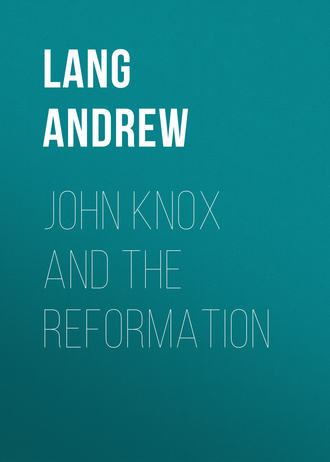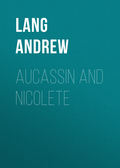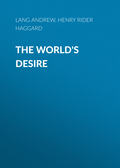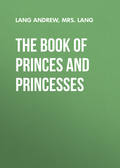
Lang Andrew
John Knox and the Reformation
Knox wrote thus on May 16, 1566. 194 He was a little irritated at that time by Queen Mary’s triumph over his friends, the murderers of Riccio, and his own hasty flight from Edinburgh to Kyle. This may excuse the somewhat unusual and even unbecoming nature of his language concerning the dying lady, but his memory was quite wrong about his prophecy. The symptoms of the Regent’s malady had begun more than a week before the Anglo-Scottish defeat at Leith, and the nature of her complaint ought to have been known to the prophet’s party, as her letter, describing her condition, had been intercepted and deciphered. But the deciphering may have been done in England, which would cause delay. We cannot, of course, prove that Knox was informed as to the Regent’s malady before he prophesied; if so, he had forgotten the fact before he wrote as he did in 1566. But the circumstances fail to demonstrate that he had a supernormal premonition, or drew a correct deduction from Scripture, and make it certain that the Regent did not fall ill after his prophecy.
The Regent died on June 11, half-an-hour after the midnight of June 10. A report was written on June 13, from Edinburgh Castle, to the Cardinal of Lorraine, by Captain James Cullen, who some twelve years later was hanged by the Regent Morton. He says that since June 7, Lord James and Argyll, Marischal, and Glencairn, had assiduously attended on the dying lady. Two hours before her death she spoke apart for a whole hour with Lord James. Chatelherault had seen her twice, and Arran once. 195 Knox mentions the visits of these lords, and says that d’Oysel was forbidden to speak with her, “belike she would have bidden him farewell, for auld familiarity was great.”
According to Knox, the Regent admitted the errors of her policy, attributing it to Huntly, who had deserted her, and to “the wicked counsel of her friends,” that is, her brothers. At the request of the Lords, she saw Willock, and said, as she naturally would, that “there was no salvation but in and by the death of Jesus Christ.” “She was compelled.. to approve the chief head of our religion, wherein we dissent from all papists and popery.” Knox had strange ideas about the creed which he opposed. “Of any virtue that ever was espied in King James V. (whose daughter she,” Mary Stuart, “is called”), “to this hour (1566) we have seen no sparkle to appear.” 196
With this final fling at the chastity of Mary of Guise, the Reformer takes leave of the woman whom he so bitterly hated. Yet, “Knox was not given to the practice so common in his day, of assassinating reputations by vile insinuations.” Posterity has not accepted, contemporary English historians did not accept, Knox’s picture of Mary of Guise as the wanton widow, the spawn of the serpent, who desired to cut the throat of every Protestant in Scotland. She was placed by circumstances in a position from which there was no issue. The fatal French marriage of her daughter was a natural step, at a moment when Scottish independence could only be maintained by help of France. Had she left the Regency in the hands of Chatelherault, that is, of Archbishop Hamilton, the prelate was not the man to put down Protestantism by persecution, and so save the situation. If he had been, Mary of Guise was not the woman to abet him in drastic violence. The nobles would have revolted against the feeble Duke. 197
On July 6, the treaty of Edinburgh was concluded by representatives of England (Cecil was one) and of France. The Reformers carried a point of essential importance, the very point which Knox told Croft had been secured by the Appointment of July 1559. All French forces were to be dismissed the country, except one hundred and twenty men occupying Dunbar and Inchkeith, in the Firth of Forth. A clause by which Cecil thought he had secured “the kernel” for England, and left the shell to France, a clause recognising the “rightfulness” of Elizabeth’s alliance with the rebels, afforded Mary Stuart ground, or excuse, for never ratifying the treaty.
It is needless here to discuss the question – was the Convention of Estates held after the treaty, in August, a lawful Parliament? There was doubt enough, at least, to make Protestants feel uneasy about the security of the religious settlement achieved by the Convention. Randolph, the English resident, foresaw that the Acts might be rescinded.
Before the Convention of Estates met, a thanksgiving day was held by the brethren in St. Giles’s, and Knox, if he was the author of the address to the Deity, said with scientific precision, “Neither in us, nor yet in our confederates was there any cause why thou shouldst have given unto us so joyful and sudden a deliverance, for neither of us both ceased to do wickedly, even in the midst of our greatest troubles.” Elizabeth had lied throughout with all her natural and cultivated gift of falsehood: of the veracity of the brethren several instances have been furnished.
Ministers were next appointed to churches, Knox taking Edinburgh, while Superintendents (who were by no means Bishops) were appointed, one to each province. Erskine of Dun, a layman, was Superintendent of Angus. A new anti-Catholic Kirk was thus set up on July 20, before the Convention met and swept away Catholicism. 198 Knox preached vigorously on “the prophet Haggeus” meanwhile, and “some” (namely Lethington, Speaker in the Convention) “said in mockage, we must now forget ourselves, and bear the barrow to build the houses of God.” The unawakened Lethington, and the gentry at large, merely dilapidated the houses of God, so that they became unsafe, as well as odiously squalid. That such fervent piety should grudge repairs of church buildings (many of them in a wretched state already) is a fact creditable rather to the thrift than to the state of grace of the Reformers. After all their protestations, full of texts, the lords and lairds starved their preachers, but provided, by roofless aisles and unglazed windows, for the ventilation of the kirks. These men so bubbling over with gospel fervour were, in short, when it came to practice, traitors and hypocrites; nor did Knox spare their unseemly avarice. The cause of the poor, and of the preachers, lay near his heart, and no man was more insensible of the temptations of wealth.
Lethington did not address the Parliament as Speaker till August 9. Never had such a Parliament met in Scotland. One hundred and six barons, not of the higher order, assembled; in 1567, when Mary was a prisoner and the Regent Moray held the assembly, not nearly so many came together, nor on any later occasion at this period. The newcomers claimed to sit “as of old custom”; it was a custom long disused, and not now restored to vitality.
A supplication was presented by “the Barons, gentlemen, Burgesses, and others” to “the nobility and Estates” (of whom they do not seem to reckon themselves part, contrasting themselves with “yourselves”). They reminded the Estates how they had asked the Regent “for freedom and liberty of conscience with a godly reformation of abuses.” They now, by way of freedom of conscience, ask that Catholic doctrine “be abolished by Act of this Parliament, and punishment appointed for the transgressors.” The Man of Sin has been distributing the whole patrimony of the Church, so that “the trew ministers,” the schools, and the poor are kept out of their own. The actual clergy are all thieves and murderers and “rebels to the lawful authority of Emperors, Kings, and Princes.” Against these charges (murder, rebellion, profligacy) they must answer now or be so reputed. In fact, it was the nobles, rather than the Pope, who had been robbing the Kirk, education, and the poor, which they continued to do, as Knox attests. But as to doctrine, the barons and ministers were asked to lay a Confession before the House. 199
It will be observed that, in the petition, “Emperors, Kings, and Princes” have “lawful authority” over the clergy. But that doctrine assumes, tacitly, that such rulers are of Knox’s own opinions: the Kirk later resolutely stood up against kings like James VI., Charles I., and Charles II.
The Confession was drawn up, presented, and ratified in a very few days: it was compiled in four. The Huguenots in Paris, in 1559, “established a record” by drawing up a Confession containing eighty articles in three days. Knox and his coadjutors were relatively deliberate. They aver that all points of belief necessary for salvation are contained in the canonical books of the Bible. Their interpretation pertains to no man or Church, but solely to “the spreit of God.” That “spreit” must have illuminated the Kirk as it then existed in Scotland, “for we dare not receive and admit any interpretation which directly repugns to any principal point of our faith, to any other plain text of Scripture, or yet unto the rule of charity.”
As we, the preachers of the Kirk then extant, were apostate monks or priests or artisans, about a dozen of us, in Scotland, mankind could not be expected to regard “our” interpretation, “our faith” as infallible. The framers of the Confession did not pretend that it was infallible. They request that, “if any man will note in this our Confession any article or sentence repugning to God’s Holy Word,” he will favour them with his criticism in writing. As Knox had announced six years earlier, that, “as touching the chief points of religion, I neither will give place to man or angel.. teaching the contrair to that which ye have heard,” a controversialist who thought it worth while to criticise the Confession must have deemed himself at least an archangel. Two years later, written criticism was offered, as we shall see, with a demand for a written reply. The critic escaped arrest by a lucky accident.
The Confession, with practically no criticism or opposition, was passed en bloc on August 17. The Evangel is candidly stated to be “death to the sons of perdition,” but the Confession is offered hopefully to “weak and infirm brethren.” Not to enter into the higher theology, we learn that the sacraments can only be administered “by lawful ministers.” We learn that they are “such as are appointed to the preaching of the Word, or into whose mouth God has put some sermon of exhortation” and who are “lawfully chosen thereto by some Kirk.” Later, we find that rather more than this, and rather more than some of the “trew ministeris” then had, is required.
As the document reaches us, it appears to have been “mitigated” by Lethington and Wynram, the Vicar of Bray of the Reformation. They altered, according to the English resident, Randolph, “many words and sentences, which sounded to proceed rather of some evil conceived opinion than of any sound judgment.” As Lethington certainly was not “a lawful minister,” it is surprising if Knox yielded to his criticism.
Lethington and Wynram also advised that the chapter on obedience to the sovereign power should be omitted, as “an unfit matter to be treated at this time,” when it was not very obvious who the “magistrate” or authority might be. In this sense Randolph, Arran’s English friend, wrote to Cecil. 200 The chapter, however, was left standing. The sovereign, whether in empire, kingdom, duke, prince, or in free cities, was accepted as “of God’s holy ordinance. To him chiefly pertains the reformation of the religion,” which includes “the suppression of idolatry and superstition”; and Catholicism, we know, is idolatry. Superstition is less easily defined, but we cannot doubt that, in Knox’s mind, the English liturgy was superstitious. 201 To resist the Supreme Power, “doing that which pertains to his charge” (that is, suppressing Catholicism and superstition, among other things), is to resist God. It thus appears that the sovereign is not so supreme but that he must be disobeyed when his mandates clash with the doctrine of the Kirk. Thus the “magistrate” or “authority” – the State, in fact – is limited by the conscience of the Kirk, which may, if it pleases, detect idolatry or superstition in some act of secular policy. From this theory of the Kirk arose more than a century of unrest.
On August 24, the practical consequences of the Confession were set forth in an Act, by which all hearers or celebrants of the Mass are doomed, for the first offence, to mere confiscation of all their goods and to corporal punishment: exile rewards a repetition of the offence: the third is punished by death. “Freedom from a persecuting spirit is one of the noblest features of Knox’s character,” says Laing; “neither led away by enthusiasm nor party feelings nor success, to retaliate the oppressions and atrocities that disgraced the adherents of popery.” 202 This is an amazing remark! Though we do not know that Knox was ever “accessory to the death of a single individual for his religious opinions,” we do know that he had not the chance; the Government, at most, and years later, put one priest to death. But Knox always insisted, vainly, that idolaters “must die the death.”
To the carnal mind these rules appear to savour of harshness. The carnal mind would not gather exactly what the new penal laws were, if it confined its study to the learned Dr. M‘Crie’s Life of Knox. This erudite man, a pillar of the early Free Kirk, mildly remarks, “The Parliament.. prohibited, under certain penalties, the celebration of the Mass.” He leaves his readers to discover, in the Acts of Parliament and in Knox, what the “certain penalties” were. 203 The Act seems, as Knox says about the decrees of massacre in Deuteronomy, “rather to be written in a rage” than in a spirit of wisdom. The majority of the human beings then in Scotland probably never had the dispute between the old and new faiths placed before them lucidly and impartially. Very many of them had never heard the ideas of Geneva stated at all. “So late as 1596,” writes Dr. Hay Fleming, “there were above four hundred parishes, not reckoning Argyll and the Isles, which still lacked ministers.” “The rarity of learned and godly men” of his own persuasion, is regretted by Knox in the Book of Discipline. Yet Catholics thus destitute of opportunity to know and recognise the Truth, are threatened with confiscation, exile, and death, if they cling to the only creed which they have been taught – after August 17, 1560. The death penalty was threatened often, by Scots Acts, for trifles. In this case the graduated scale of punishment shows that the threat is serious.
This Act sounds insane, but the Convention was wise in its generation. Had it merely abolished the persecuting laws of the Church, Scotland might never have been Protestant. The old faith is infinitely more attractive to mankind than the new Presbyterian verity. A thing of slow and long evolution, the Church had assimilated and hallowed the world-old festivals of the year’s changing seasons. She provided for the human love of recreation. Her Sundays were holidays, not composed of gloomy hours in stuffy or draughty kirks, under the current voice of the preacher. Her confessional enabled the burdened soul to lay down its weight in sacred privacy; her music, her ceremonies, the dim religious light of her fanes, naturally awaken religious emotion. While these things, with the native tendency to resist authority of any kind, appealed to the multitude, the position of the Church, in later years, recommended itself to many educated men in Scotland as more logical than that of Knox; and convert after convert, in the noble class, slipped over to Rome. The missionaries of the counter-Reformation, but for the persecuting Act, would have arrived in a Scotland which did not persecute, and the work of the Convention of 1560 might all have been undone, had not the stringent Act been passed.
That Act apparently did not go so far as the preachers desired. Thus Archbishop Hamilton, writing to Archbishop Beaton in Paris, the day after the passing of the Act, says, “All these new preachers openly persuade the nobility in the pulpit, to put violent hands, and slay all churchmen that will not concur and adopt their opinion. They only reproach my Lord Duke” (the Archbishop’s brother), “that he will not begin first, and either cause me to do as they do, or else to use rigour on me by slaughter, sword, or, at least, perpetual prison.” 204 It is probable that the Archbishop was well informed as to what the bigots were saying, though he is not likely to have “sat under” them; moreover, he would hear of their advice from his brother, the Duke, with whom he had just held a long conference. 205 Lesley, Bishop of Ross, in his “History,” praises the humanity of the nobles, “for at this time few Catholics were banished, fewer were imprisoned, and none were executed.” The nobles interfering, the threatened capital punishment was not carried out. Mob violence, oppression by Protestant landlords, Kirk censure, imprisonment, fine, and exile, did their work in suppressing idolatry and promoting hypocrisy.
No doubt this grinding ceaseless daily process of enforcing Truth, did not go far enough for the great body of the brethren, especially the godly burgesses of the towns; indeed, as early as June 10, 1560, the Provost, Bailies, and Town Council of Edinburgh proclaimed that idolaters must instantly and publicly profess their conversion before the Ministers and Elders on the penalty of the pillory for the first offence, banishment from the town for the second, and death for the third. 206
It must always be remembered that the threat of the death penalty often meant, in practice, very little. It was denounced, under Mary of Guise (February 9, 1559), against men who bullied priests, disturbed services, and ate meat in Lent. It was denounced against shooters of wild fowl, and against those, of either religious party, who broke the Proclamation of October 1561. Yet “nobody seemed one penny the worse” as regards their lives, though the punishments of fining and banishing were, on occasions, enforced against Catholics.
We may marvel that, in the beginning, Catholic martyrs did not present themselves in crowds to the executioner. But even under the rule of Rome it would not be easy to find thirty cases of martyrs burned at the stake by “the bloudie Bishops,” between the fifteenth century and the martyrdom of Myln. By 1560 the old Church was in such a hideous decline – with ruffianly men of quality in high spiritual places; with priests who did not attend Mass, and in many cases could not read; with churches left to go to ruin; with license so notable that, in one foundation, the priest is only forbidden to keep a constant concubine – that faith had waxed cold, and no Catholic felt “ripe” for martyrdom. The elements of a League, as in France, did not exist. There was no fervently Catholic town population like that of Paris; no popular noble warriors, like the Ducs de Guise, to act as leaders. Thus Scotland, in this age, ran little risk of a religious civil war. No organised and armed faction existed to face the Congregation. When the counter-Reformation set in, many Catholics endured fines and exile with constancy.
The theology of the Confession of Faith is, of course, Calvinistic. No “works” are, technically, “good” which are not the work of the Spirit of our Lord, dwelling in our hearts by faith. “Idolaters,” and wicked people, not having that spirit, can do no good works. The blasphemy that “men who live according to equity and justice shall be saved, what religion soever they have professed,” is to be abhorred. “The Kirk is invisible,” consisting of the Elect, “who are known only to God.” This gave much cause of controversy to Knox’s Catholic opponents. “The notes of the true Church” are those of Calvin’s. As to the Sacrament, though the elements be not the natural body of Christ, yet “the faithful, in the right use of the Lord’s Table, so do eat the body and drink the blood of the Lord Jesus that He remains in them and they in Him.. in such conjunction with Christ Jesus as the natural man cannot comprehend.”
This is a highly sacramental and confessedly mystical doctrine, not less unintelligible to “the natural man” than the Catholic theory which Knox so strongly reprobated. Alas, that men called Christian have shed seas of blood over the precise sense of that touching command of our Lord, which, though admitted to be incomprehensible, they have yet endeavoured to comprehend and define!
A serious task for Knox was to draw up, with others, a “Book of the Policy and Discipline of the Kirk,” a task entrusted to them in April 1560. In politics, till January 1561, the Lords hoped that they might induce Elizabeth (then entangled with Leicester, as Knox knew) to marry Arran, but whether “Glycerium” (as Bishop Jewel calls her) had already detected in “the saucy youth” “a half crazy fool,” as Mr. Froude says, or not, she firmly refused. She much preferred Lord Robert Dudley, whose wife had just then broken her neck. The unfortunate Arran had fought resolutely, Knox tells us, by the side of Lord James, in the winter of 1559, but he already, in 1560, showed strange moods, and later fell into sheer lunacy. In December died “the young King of France, husband to our Jezebel – unhappy Francis.. he suddenly perished of a rotten ear.. in that deaf ear that never would hear the truth of God” (December 5, 1560). We have little of Knox’s poetry, but he probably composed a translation, in verse, of a Latin poem indited by one of “the godly in France,” whence he borrowed his phrase “a rotten ear” (aure putrefacta corruit).
“Last Francis, that unhappy child,
His father’s footsteps following plain,
To Christ’s crying deaf ears did yield,
A rotten ear was then his bane.”
The version is wonderfully close to the original Latin.
Meanwhile, Francis was hardly cold before Arran wooed his idolatrous widow, Queen Mary, “with a gay gold ring.” She did not respond favourably, and “the Earl bare it heavily in his heart, and more heavily than many would have wissed,” says Knox, with whom Arran was on very confidential terms. Knox does not rebuke his passion for Jezebel. He himself “was in no small heaviness by reason of the late death of his dear bedfellow, Marjorie Bowes,” of whom we know very little, except that she worked hard to lighten the labours of Knox’s vast correspondence. He had, as he says, “great intelligence both with the churches and some of the Court of France,” and was the first to receive news of the perilous illness of the young King. He carried the tidings to the Duke and Lord James, at the Hamilton house near Kirk o’ Field, but would not name his informant. Then came the news of the King’s death from Lord Grey de Wilton, at Berwick, and a Convention of the Nobles was proclaimed for January 15, 1561, to “peruse newly over again” the Book of Discipline.







